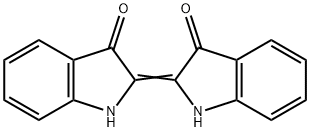PRODUCT Properties
| Melting point: | >300 °C(lit.) |
| Boiling point: | 405.51°C (rough estimate) |
| Density | 1.01 g/mL at 20 °C |
| vapor pressure | 0Pa at 100℃ |
| refractive index | 1.5800 (estimate) |
| Flash point: | >220℃ |
| storage temp. | Sealed in dry,Room Temperature |
| solubility | DMSO (Slightly, Heated, Sonicated), DMF (Slightly) |
| form | Powder |
| Colour Index | 73000 |
| pka | -3.83±0.20(Predicted) |
| color | Dark blue to violet |
| Water Solubility | <0.1 g/100 mL |
| λmax | 602 nm |
| ε(extinction coefficient) | ≥8000 at 599-605nm in chloroform |
| Merck | 14,4943 |
| BRN | 88275 |
| Stability: | Stable. Incompatible with strong oxidizing agents. |
| InChIKey | COHYTHOBJLSHDF-BUHFOSPRSA-N |
| LogP | 2.7 at 23℃ |
| CAS DataBase Reference | 482-89-3(CAS DataBase Reference) |
| NIST Chemistry Reference | c.i. Vat blue 1(482-89-3) |
| EPA Substance Registry System | C.I. Vat Blue 1 (482-89-3) |
Description and Uses
Indigo, known chemically as indigotin, is a common blue dye that has been highly valued
throughout history and has played a major role in trade and commerce since ancient times.
The term indigo is often used to describe many blue dyes produced from a number of plants.
For example, woad, a blue dye obtained from the plant Isatis tinctoria, was used throughout
the Mediterannean and Europe and is often identified as indigo. True indigo comes from
the leguminous plant of the genus Indigofera.
The Indigofera genus includes several hundred
species, and indigo has been obtained from a number of these, but the dominant species for
the dye are Indigofera tinctoria grown mainly in India and tropical Asia and Indigofera suff ructiosa
from the tropical Americas. The name indigo comes from the Greek indikon and Latin
indicum meaning “dye from India.” There is evidence that indigo was used several thou sand
years b.c.e. Persian rugs containing indigo color exist from several thousand years b.c.e. Textile
artifacts from Egyptian tombs provide evidence of indigo’s use by royalty from as far back as
2500 b.c.e. The writings of Herodotus from approximately 450 b.c.e. mention indigo’s use in
the Mediterranean area.
Indigo is a chemical compound used as a dye in industrial clothing and textile processes. Also used in the synthesis of organic semiconductors. Dyes and metabolites.
Safety
| Symbol(GHS) |  GHS07 |
| Signal word | Warning |
| Hazard statements | H315-H319-H335 |
| Precautionary statements | P302+P352-P305+P351+P338 |
| Hazard Codes | Xi,Xn |
| Risk Statements | 36/38-36/37/38-48/20/21/22 |
| Safety Statements | 26-36 |
| RIDADR | UN 3264 8/PG 3 |
| WGK Germany | 1 |
| RTECS | DU2988400 |
| HS Code | 32041510 |
| Hazardous Substances Data | 482-89-3(Hazardous Substances Data) |
| Toxicity | LD50 oral in mouse: > 32gm/kg |


